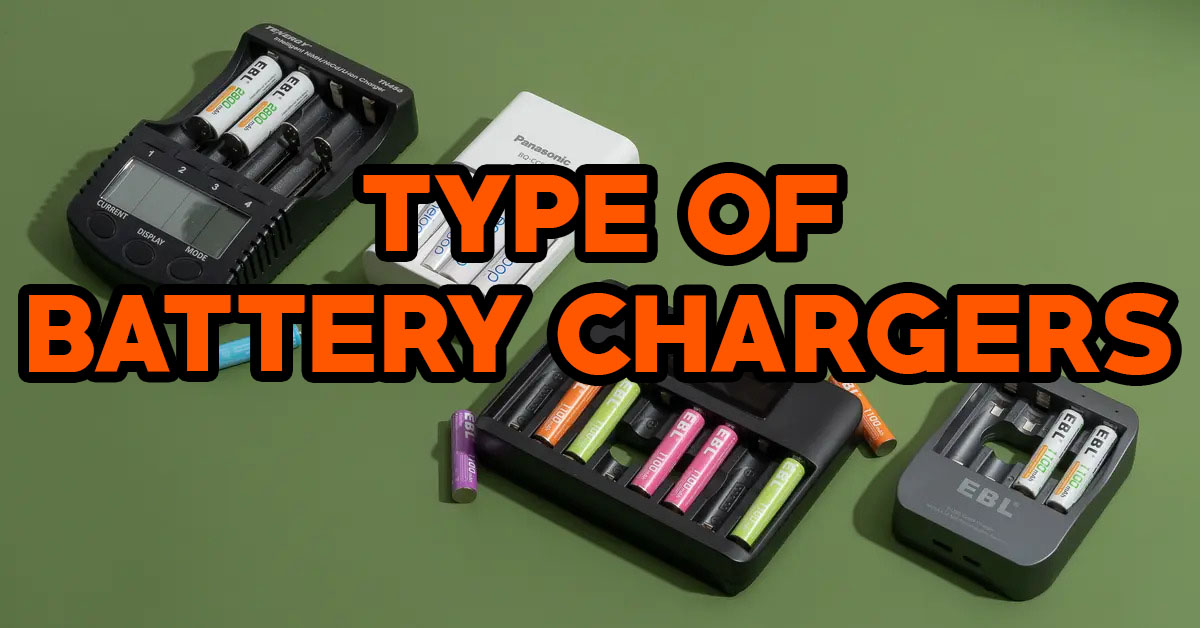

Types of Battery Chargers: Everything You Need to Know

The battery charger ensures the continued operation of electronic gadgets and appliances by recharging different types of batteries. Several types of battery chargers exist now due to technological advances, each catering to a different chemistry, voltage, and capacity. Direct current (DC), alternating current (AC), and wireless chargers each have different charging speeds, efficiency, and methods for supplying power to the battery. By knowing the different types of battery chargers, consumers can choose the right one based on their specific needs, whether they are using the charger for electronic devices, home appliances, or electric vehicles.
How Do Battery Chargers Work?
Charging a battery involves transferring electricity from an external source to the battery, which restores its charge. Batteries are recharged by chargers that supply direct current (DC) to the battery to reverse the chemical reactions that occur when they are discharged. A battery's needs and the type of charger determine the amount of voltage and current supplied. Depending on the battery's charge level, some chargers deliver a constant current. In the process of charging, the battery gradually fills up with energy, which can then be used later for powering devices.
The charging process is optimized with the use of smart charging technology in many modern chargers. Battery voltage, current, and temperature are monitored by sensors and microcontrollers in these chargers. A "bulk" charging phase occurs when the battery is low and requires a higher current to be recharged quickly. In order to protect the battery from overcharging, the charger reduces the current as the battery gets closer to full charge, which can result in heat buildup, reduced battery life, and even leaks. Through this method, batteries are charged stage by stage, maximizing their efficiency and extending their life span.
As well as safety features, advanced chargers also have different charging modes. They can detect batteries by type, such as lithium-ion, nickel-cadmium, or lead-acid, and adjust their output accordingly. Trickle or maintenance modes can also be available, which maintain battery power without overcharging. A battery charger ensures that batteries are charged quickly, safely, and without damage by controlling the current flow and using smart technology. Various electronic devices, cars, power tools, and even small electronics can use modern battery chargers because of this versatility.
Types of Battery Chargers
Various types of battery chargers have evolved as technology has progressed. A few types of battery chargers can be found on the market today:
Manual Battery Chargers
Battery chargers that require the user to monitor and control the charge process are more basic and hands-on. An automatic or smart charger detects when the battery is fully charged and adjusts the charging current automatically, whereas manual chargers do not. Charge mistakes must be avoided by the user, preventing overcharging or undercharging the battery. Some older lead-acid batteries as well as some NiCd (Nickel-Cadmium) batteries are equipped with these chargers.
How Manual Battery Chargers Work
The user must manually disconnect the charger once he or she determines the battery is fully charged using a manual battery charger. Indicators and simple gauges may be provided on the charger to aid in monitoring the charging process, but users should be aware of overcharging to avoid damage to the battery. Users must check the battery's voltage or use a timer to gauge when the charger should be disconnected, since these chargers do not automatically shut off when the battery is full. Manual chargers therefore require more attention and vigilance than automatic chargers.
Applications of Manual Battery Chargers
In certain applications, such as power tools, emergency lighting, and older electronic devices, manual battery chargers can be used to charge older battery chemistries, including NiCd and NiMH batteries. Hobbyists often prefer to manually manage charging processes in some devices, such as model trains, radios, and drones. As well as lead-acid batteries, manual chargers can be used for the charging of motorcycle, lawnmower, and backup power systems batteries, where people may prefer to monitor and control the charging process closely.
Automatic Battery Chargers
A battery charger that automatically recharges batteries with advanced technology does not require constant monitoring or manual operation. The current and voltage of automatic chargers can be adjusted automatically based on the battery's charge level via sensors and circuits, and the charging will stop when the battery is fully charged. In addition to making them a convenient and hands-free solution, their self-regulating feature also prevents problems such as overcharging, overheating, and battery damage. Nickel-based batteries, lead-acid batteries, and lithium-ion batteries are commonly charged using these chargers.
How Automatic Battery Chargers Work
Automatic battery chargers measure voltage, current, and sometimes temperature to determine the battery's state of charge (SOC). In the initial stages of charging, the charger delivers a higher current to quickly charge the battery. To avoid overcharging as the battery nears full capacity, a charger gradually decreases the current. A multi-stage charging process is often used by automatic chargers to maximize battery life and performance, including stages such as bulk, absorption, and float charging.
Applications of Automatic Battery Chargers
Various applications rely on automatic battery chargers for safety, convenience, and battery health. Automobile batteries are commonly maintained with them, especially when they are stored for long periods. A wide variety of consumer electronics devices use automatic chargers, including laptops, power tools, and drones. Renewable energy setups also benefit from automatic chargers, as solar energy storage systems utilize regulated charging to keep batteries charged. A backup power supply, for example, requires batteries to remain fully charged to avoid overcharging, which can lead to industrial and emergency systems using them.
Solar Battery Chargers
Using photovoltaic (PV) cells, solar battery chargers convert solar energy into electrical energy to recharge batteries. In places where conventional power sources are unavailable, such as remote locations or off-grid areas, they are a reliable and sustainable solution to power electronics. The battery of a smartphone, laptop, or portable power bank can be charged using a solar charger, as well as in RVs, boats, and home solar systems. For environmentally conscious individuals looking to reduce their carbon footprint, their reliance on renewable energy makes them a great choice.
How Solar Battery Chargers Work
Batteries that are charged with solar energy are charged with direct current electricity produced by PV cells on solar panels. A connected battery or device is then charged using this electricity. The majority of solar chargers have a built-in charge controller to prevent overcharging and damage to the batteries. Users can charge multiple devices simultaneously with some advanced solar chargers that feature multiple charging outputs, such as USB ports. The majority of solar chargers can be charged by sunlight, but many also have built-in batteries, making them practical for varied weather and time of day conditions.
Applications of Solar Battery Chargers
A solar battery charger is a popular alternative to conventional sources of power in outdoor and off-grid applications. For charging smartphones, GPS devices, and power banks, they are popular among campers, hikers, and travelers. For use in RVs, boats, and remote cabins, large solar chargers provide sustainable energy for lighting, appliances, and other necessities. In developing regions without access to electricity, solar chargers are the most cost-effective, sustainable energy solution. During power outages, solar chargers are also essential backup power sources for critical devices in disaster preparedness and emergency kits.
Trickle Chargers
A trickle charger maintains a battery's full capacity without overcharging it by providing a slow, constant charge. Trickle chargers deliver a small, steady current over a long period of time, as opposed to standard chargers that deliver a high current to quickly charge the battery. Battery discharge can occur when left idle for too long, which is why slow charging prevents it from self-discharging. Infrequently used vehicles like motorcycles and boats often require trickle chargers, such as automotive batteries and lawn equipment.
How Trickle Chargers Work
An electric trickle charger provides a low current that counteracts the self-discharge rate of the battery. Trickle chargers charge batteries gently and keep them topped up without overcharging them when connected to batteries. When the battery reaches full charge, some trickle chargers must be disconnected manually. Many modern trickle chargers, however, come with smart charging technology that shuts off when the battery is fully charged, ensuring that the battery is being charged smoothly and consistently without the risk of overcharging.
Applications of Trickle Chargers
Vehicles or equipment that are stored for an extended period of time typically require trickle chargers. The battery is regularly maintained in cars, RVs, and motorcycles that are stored over winter, so they will be in good condition when the vehicle is ready to use again. Besides lawnmowers and boats, these devices are often used for seasonal equipment that sits idle for extended periods. Moreover, trickle chargers are used to maintain battery charge in backup power systems.
Final Verdict
The right type of battery charger is critical to ensuring battery longevity and meeting your needs. From quick charging to keeping batteries healthy for long periods of time, every type of charger offers unique advantages. Battery type, charging frequency, and charging environment all play a role in choosing the right charger. Your batteries will last longer when you invest in the right charger, helping you get the most out of your devices and equipment. Chargers come in a wide range of sizes and styles, ensuring that you have a suitable solution for every usage scenario.
Related Articles
Introduction to Endpoint Security
Thyristor Controlled Reactor (TCR) and Thyristor Switched Capacitor (TSC)
Different Types of Audio Cables and How to Pick the Right One
Lithium CR1620 Battery: Application and Features
Introduction to Optical Sensor
Subscribe to JMBom Electronics !













